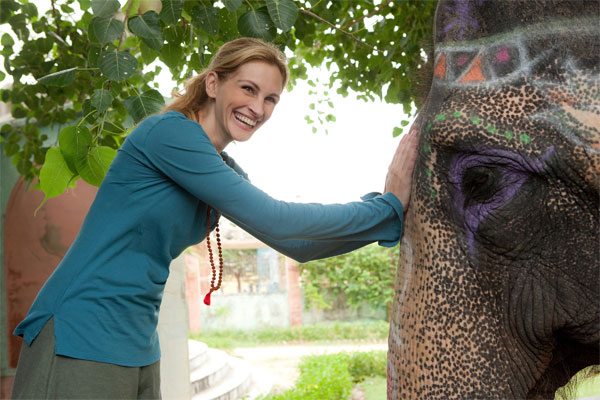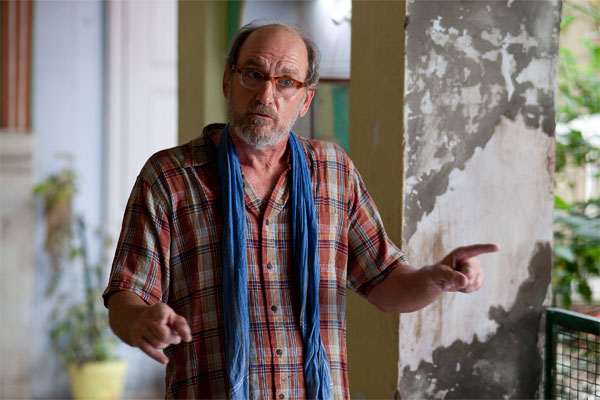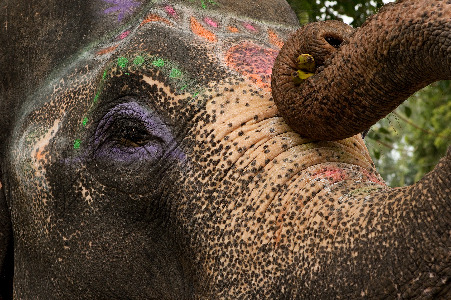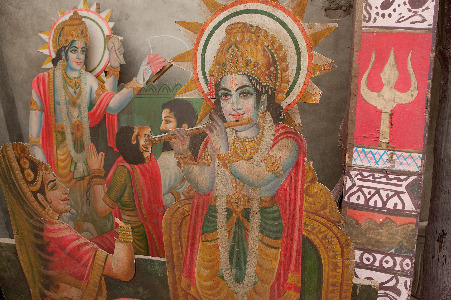
On location in India in Columbia Pictures' EAT PRAY LOVE. © 2010 CTMG, Inc. All Rights Reserved.
Eat, Pray, Love is a Julia Roberts movie. Her elegantly chiseled features, distinctive curled upper lip and large, limpid brown eyes dominate the movie. It’s a travelogue all right – a travelogue of Julia’s face and her familiar, and limited, emotional range.
First, the positive
There are two things I like about Eat, Pray, Love. One, the male cast members. The filmmakers very wisely decided to surround the leading lady with excellent actors. James Franco, Billy Crudup and Javier Bardem are all excellent as the men in her life. The love story in Bali with Bardem is the best part of the movie. If they had simply made it a love story, set in the lush tropics of Bali, it would have been much more satisfying.

On location in India in Columbia Pictures' EAT PRAY LOVE. © 2010 CTMG, Inc. All Rights Reserved.
The star of the show is Richard Jenkins, who was also excellent in The Visitor. It’s worth the price of admission to see his scene on the roof of the ashram, when he tells Julia/Liz about losing his family. It’s the emotional centre of the film, and the raw honesty of that scene makes the rest of it look like an episode of The Love Boat.
The other thing I like is, of course, the travel photography—the scenes of Italy and Bali are lovely. But how they could make sun-filled India look like Transylvania on a bad day is beyond me. And for the record, I stay in a lovely, clean ashram, full of white, airy buildings on acres of gorgeous gardens dripping with huge tropical flowers. It is a veritable garden-of-eden (to see pictures, read my post Auorvalley Ashram: A haven of peace and conscious living). I understand they chose this ashram in the movie because it’s close to the airport. They make it look like the airport hotel of ashrams. Oh, what a wasted opportunity to show how splendid and beautiful an ashram can be!
Missed opportunities
I have three main problems with the Eat, Pray, Love movie:
- I don’t know what it is about,
- it’s awash in wasted opportunities, and
- it makes India look dark and gloomy.
I have spent hours thinking about this movie, trying to figure out what it is about, I really have. And therein lies the problem – should a movie that purportedly celebrates the joy of traveling, eating, praying and loving in exotic destinations be so difficult to grasp?
Maybe there is nothing to grasp. Maybe that’s the problem. The main character – Eat, Pray, Love book author Elizabeth Gilbert, played by Julia Roberts – is not interesting and her situation is just not compelling. She’s young, beautiful and successful and keeps falling in love with hunky men, who fall madly in love with her, too. It’s really hard to feel sorry for her; it’s really hard to understand her angst. And the problem is compounded by the charismatic Ms. Roberts’ limited acting abilities.

On location in India in Columbia Pictures' EAT PRAY LOVE. © 2010 CTMG, Inc. All Rights Reserved.
EPL: Elephant Pushes Lady
This is movie that desperately needs a metaphor. Here’s one for you – and it is from one of my favourite scenes in the film. Julia/Liz is sitting outdoors at the ashram in India when a painted elephant starts walking towards her. She has been warned that a rogue elephant is on the loose, so she is naturally apprehensive. (By the way, this actually happened last spring when I was at my ashram in north India – though I never saw the elephant).
She gets up and touches the elephant and the elephant playfully responds, with no sign of aggression. The scene ends. It’s a lovely moment and the filmmakers do nothing with it. Julia/Liz doesn’t seem to learn anything from it; there is no epiphany; it doesn’t move the plot forward; nothing. That’s what this movie is like. Pushing an elephant. And missed opportunities.
There are so many missed opportunities in this movie! It’s heartbreaking. Kind of like visiting Shimla and seeing all the shabby cafes lining the ridge, in the way of the view of the Himalayas, rather than taking advantage of it.
Here’s another potential metaphor. Again at the ashram, our heroine gives up her SILENT badge to become a group hostess, kind of like Julie on The Love Boat. (Why does this movie keep making me think of The Love Boat?!?) She misses her opportunity to actually experience India, spiritual awareness and the chance to begin to transcend her ego.

On location in India in Columbia Pictures' EAT PRAY LOVE. © 2010 CTMG, Inc. All Rights Reserved.
So my top two problems are related – and ironic given that this story is supposedly about a woman who goes in search of herself to an ashram in India. From a yoga perspective, the Julia/Liz character confuses her ego with her Self. Her angst stems from her egotism and her inability to commit to anything larger than herself. And her character – and therefore the movie – is severely limited by this egotistic perspective. She doesn’t transcend her ego, she doesn’t have a spiritual epiphany, she doesn’t open herself to god – she just falls in love again. What’s in it for me, the viewer?
But I’m still puzzled about what this movie is about. I think it’s about how Julia/Liz had to travel to Bali to finally commit to a man. Maybe the scriptwriters got Eat, Pray, Love and author Elizabeth Gilbert’s following book, Committed, mixed up when they were writing.
Okay, I’ve done way too much hair pulling and teeth-knashing over this movie. I’m going to meditate.
My word for this movie is boring.

Mariellen Ward is a freelance travel writer whose personal style is informed by a background in journalism, a dedication to yoga and a passion for sharing the beauty of India’s culture and wisdom with the world. She has traveled for about a year altogether in India and publishes an India travel blog, Breathedreamgo.com. Mariellen also writes for magazines and newspapers.








